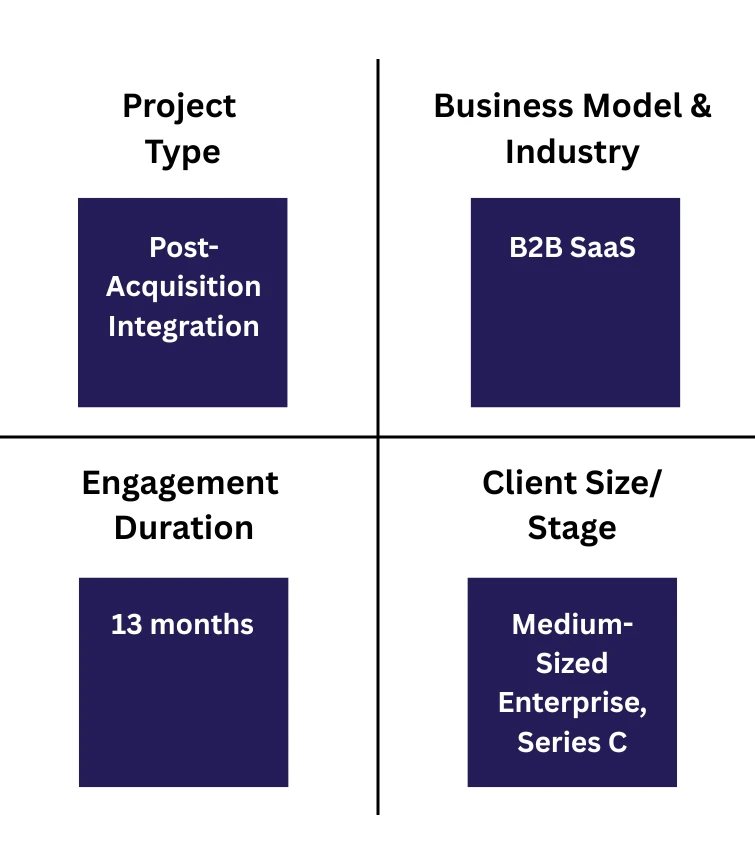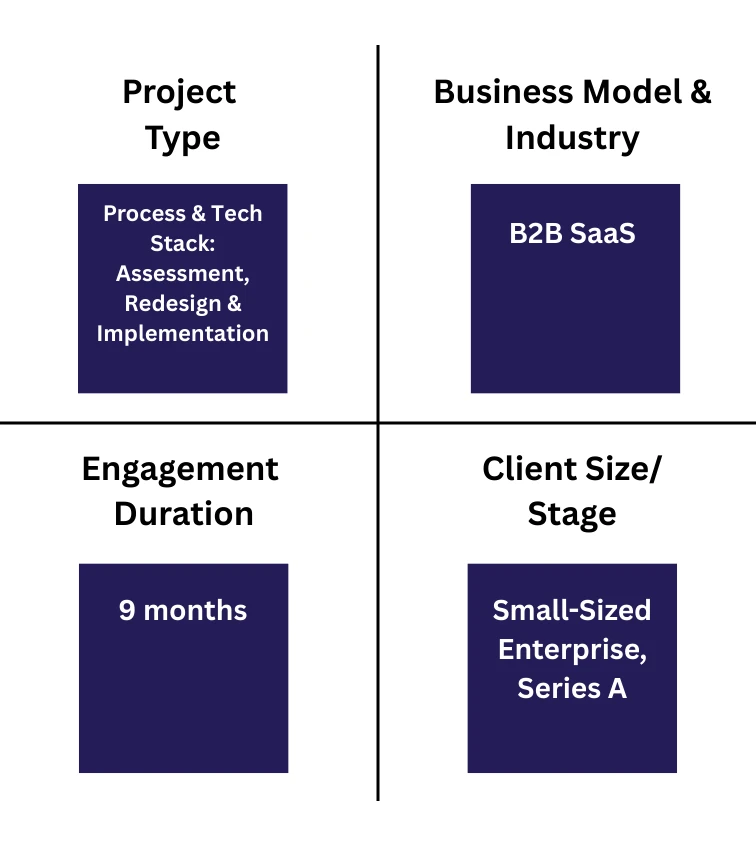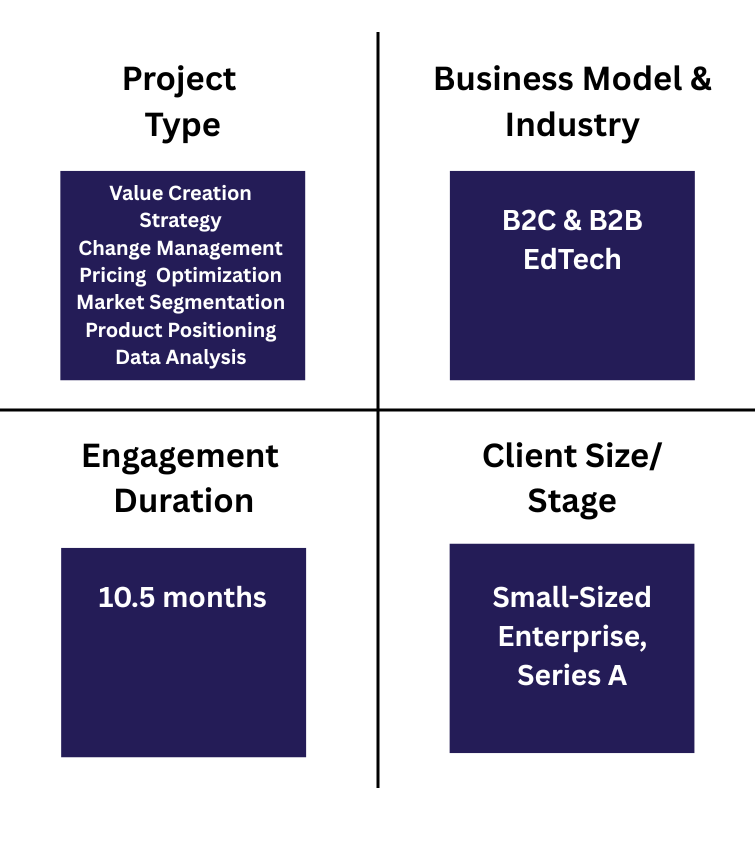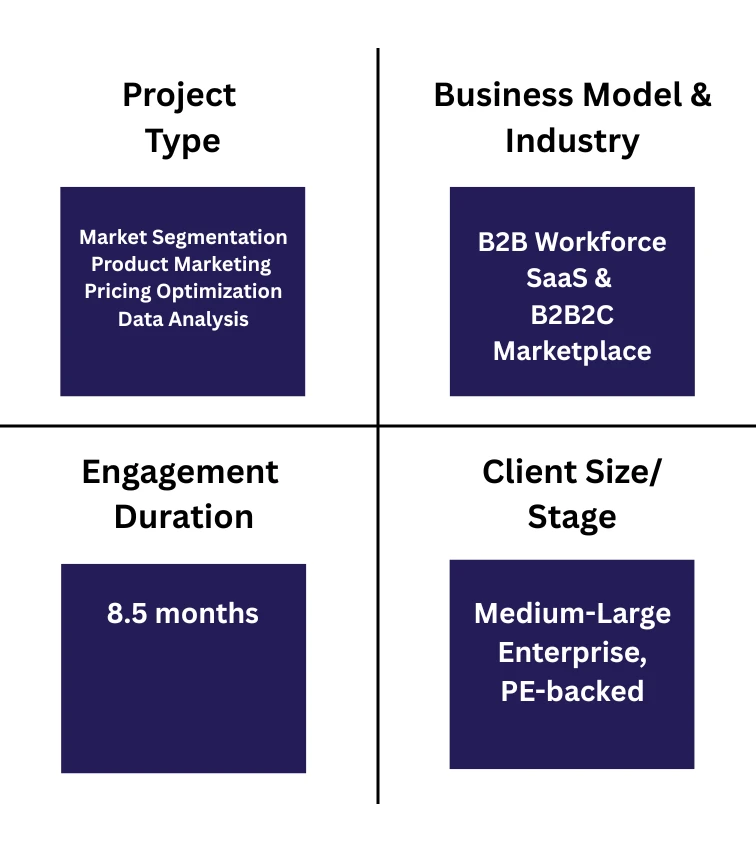Grow Sharp Consulting
Case Studies
by Rachel Bassini

CASE STUDY #1: THE INTEGRATION


The Problem:
The client had just acquired a competitor with some products that were complementary & some redundant with their pre-existing product suite. Acquired customers fit the client's Ideal Customer Profile to varying degrees. Within the acquired talent, there were some redundancies, some poor cultural fits & some with integral institutional knowledge about the acquired company's products, services, tech stack & customers.
The Action:
My goal was to define an ideal state post-acquisition, devise a game plan to achieve that state and implement it.
To do so, I analyzed:
- Acquired product analytics
- Cross-sell & upsell opportunities across both customer bases & products
- Costs of product upkeep, sales & customer service
- Net lifetime values of all customers
With these analyses, I could determine which:
- Acquired products to maintain, sunset or integrate with existing suite
- Customers to maintain and nurture, talent to retain/train.
Additionally, I designed a future state processes & tech stack to accommodate & facilitate those processes, ensuring that the required workflows & data collection of the acquired company were fully incorporated. The work entailed adapting the acquiring company’s existing tech stack & training the acquired company’s employees.
The Results:
- 85% close rate of projected upsell & cross-sell opportunities
- 25% savings of the acquired company's costs by sunseting products with low projected ROI for the future merged company & by letting go of acquired talent with redundant skillsets or poor cultural fit
- 100% retention of the acquired talent identified as critical to future Ops, by implementing my workforce integration recommendations
I led the integration of the product suites and tech stacks within my projected timeframe.
CASE STUDY #2: THE OPS AUDIT & TRANSFORMATION


The Problem:
Each functional area within the client's org. was operating in a siloed manner, with inadequate transparency across teams. Processes & tech stacks did not align cross-functionally or facilitate accomplishment of key goals. The resulting issues included unreliable data infrastructure, low conversion rates as leads were transferred from Marketing to Sales, low customer retention due to sub-optimal handoff of new clients from Sales to Customer Service, & frustrated team members.
The Action:
I analyzed all current processes & tech stacks, identifying areas of inefficiency, friction, or redundant or dirty data. Then I designed a future Ops state in which each functional area's processes were fully aligned with one another & designed to enable specific objective achievement on a company & team level. To bring objective achievement front & center, I devised an OKR system that clearly conveyed the relationships between the targets & goals of individuals, teams & the company, with personalized dashboards showing progress against those targets & projected results. I defined & then implemented an integrated tech stack that facilitated the newly designed processes.
The Results:
- 15% average increase in conversion rates across the pipeline
- 20% shorter sales cycles
- 15%-20% higher client retention rates, upsells, & NPS scores
Team members reported much less frustration due to drastically reduced time with data entry/ cleaning, not having to chase others down for key information, & generally enjoying a much more effective collaborative environment.
CASE STUDY #3: ROI-DRIVEN PRODUCT & CUSTOMER PRIORITIZATION


The Problem:
The client had a large & unwieldy suite of products & services, some B2B & some B2C, some with subscription models & some with single purchases, all serving a too-broad array of client types. The overall result was a lack of organizational focus & they needed help identifying the ROIs of their range of activities in order to prioritize, as well as packaging their products & services with appropriate pricing and positioning.
The Action:
I began with customer segmentation of their current customers, pipeline & addressable market to then identify the few most profitable segments they were best equipped to serve with a focused subset of their pre-existing products & services. I then packaged those products & services according to segment type & use case, & proposed an optimized pricing scheme I derived through both competitive analysis & analysis of their current products' pricing, margins, usage analytics, renewal rates, & NPS scores.
The Results:
- 20% revenue increase by focusing on the profitable segments with targeted messaging & product packaging/pricing designed for those segments
- 15% cost reduction by eliminating or merging some products & services
- 17% client retention increase & 10% average deal size increase due to superior product-market fit
CASE STUDY #4: THE OPS AUDIT & TRANSFORMATION


The Problem:
The client's product had multiple features that allowed it to theoretically serve a very wide range of use cases & enterprise clients in multiple industries. They needed a data-driven strategy to determine which industries & use cases to focus their GTM efforts on, which included a need for new pricing, positioning, & targeting strategy.
The Action:
I mapped out client industry & use case, along with TAM, as determined by my market research. Through competitive analysis, I determined to what degree each client industry & use case was already saturated with similar solutions, how my client's product was meaningfully differentiated from competitors' & how price points compared. I supplemented this quantitative analysis with qualitative data gathered via market interviews with decision makers in the industries of consideration to gauge degree of need & most pressing industry-specific pain point(s).
Using a weighted scoring system, I was able to identify which client industries & use cases had the highest potential ROI given a price point I recommended. From market interviews, I synthesized the product positioning & messaging that would most resonate with those prospective client industries & their decision-makers, working with the Marketing to create corresponding collateral & Sales for training to sell into the select industries.
The Results:
A year after this project, the client reported well above benchmark conversion, renewal, & upsell rates from the client industries I identified as best fit/ highest ROI & for whom I developed industry-specific product marketing strategy.